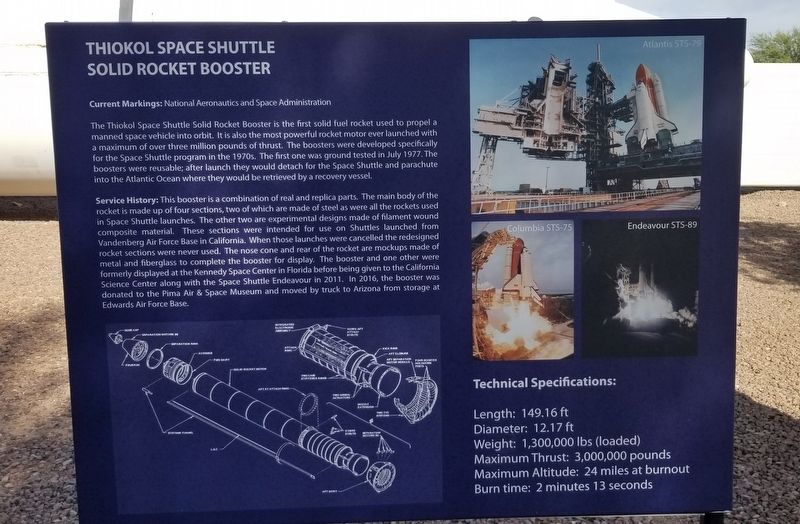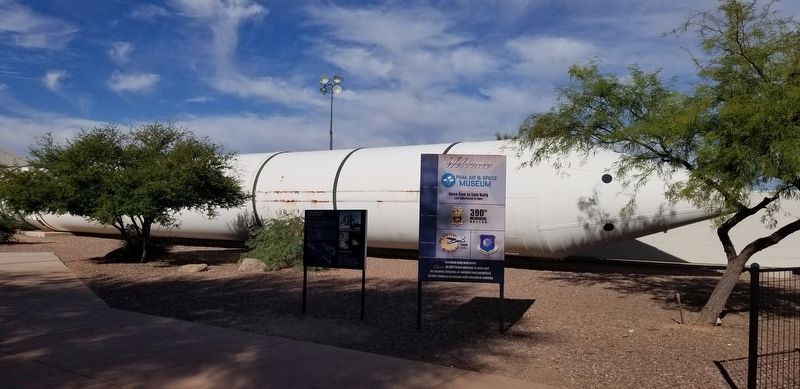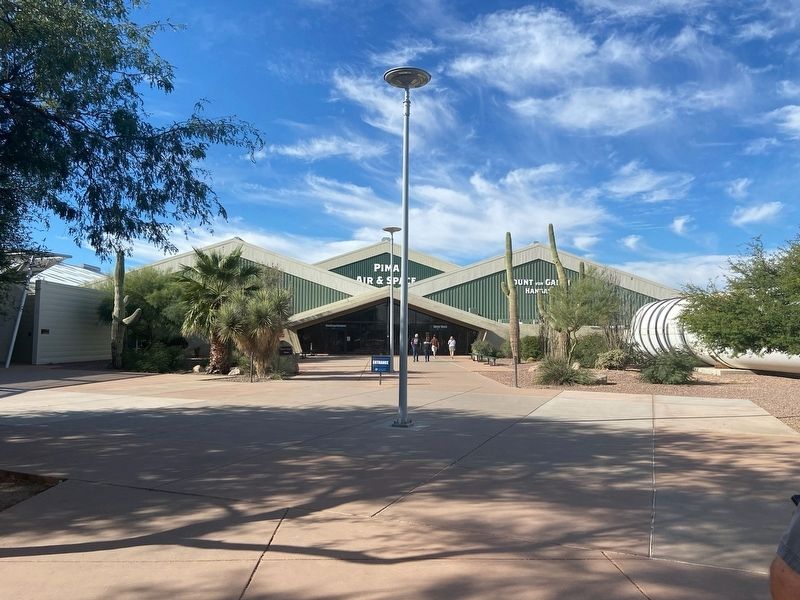Thomas Jay Park in Tucson in Pima County, Arizona — The American Mountains (Southwest)
Thiokol Space Shuttle Solid Rocket Booster
The Thiokol Space Shuttle Solid Rocket Booster is the first solid fuel rocket used to propel a manned space vehicle into orbit. It is also the most powerful rocket motor ever launched with a maximum of over three million pounds of thrust. The boosters were developed specifically for the Space Shuttle program in the 1970s. The first one was ground tested in July 1977. The boosters were reusable; after launch they would detach for the Space Shuttle and parachute into the Atlantic Ocean where they would be retrieved by a recovery vessel.
Service History: This booster is a combination of real and replica parts. The main body of the rocket is made up of four sections, two of which are made of steel as were all the rockets used in Space Shuttle launches. The other two are experimental designs made of filament wound composite material. These sections were intended for use on Shuttles launched from Vandenberg Air Force Base in California. When those launches were cancelled the redesigned rocket sections were never used. The nose cone and rear of the rocket are mockups made of metal and fiberglass to complete the booster for display. The booster and one other were formerly displayed at the Kennedy Space Center in Florida before being given to the California Science Center along with the Space Shuttle Endeavour in 2011. In 2016, the booster was donated to the Pima Air & Space Museum and moved by truck to Arizona from storage at Edwards Air Force Base.
Technical Specifications:
Length: 149.16 ft
Diameter: 12.17 ft
Weight: 1,300,000 lbs (loaded)
Maximum Thrust: 3,000,000 pounds
Maximum Altitude: 24 miles at burnout
Burn time: 2 minutes 13 seconds
Captions
Top Right: Atlantis STS-79
Middle Right (L): Columbia STS-75
Middle Right (R): Endeavour STS-89
Erected by Pima Air & Space Museum.
Topics. This historical marker is listed in this topic list: Air & Space. A significant historical month for this entry is July 1977.
Location. 32° 8.403′ N, 110° 51.915′ W. Marker is in Tucson, Arizona, in Pima County. It is in Thomas Jay Park. Marker can be reached from East Valencia Road, 0.3 miles east of South Wilmot Road. The marker is located at the entrance to the Pima Air & Space Museum. Touch for map. Marker is at or near this postal address: 6000 East Valencia Road, Tucson AZ 85756, United States of America. Touch for directions.
Other nearby markers. At least 8 other markers are within walking distance of this marker. Mil Mi-24D Hind-D (about 400 feet away, measured in a direct line); McDonnell Douglas F-15A (about 500 feet away); Sikorsky CH-54A Tarhe (Skycrane) (about 500
feet away); Sikorsky MH-53M Pave Low IV (about 500 feet away); Douglas A4D Skyhawk (about 500 feet away); McDonnell Douglas (Boeing) F/A-18A Hornet (about 500 feet away); McDonnell Douglas F-4C (about 500 feet away); Boeing Vertol CH-46E Sea Knight (about 500 feet away). Touch for a list and map of all markers in Tucson.
Also see . . . Space Shuttle Solid Rocket Booster.
The Space Shuttle Solid Rocket Booster (Space Shuttle SRB) was the first solid-propellant rocket to be used for primary propulsion on a vehicle used for human spaceflight and provided 85% of the Space Shuttle's thrust at liftoff and for the first two minutes of ascent. After burnout, they were jettisoned and parachuted into the Atlantic Ocean where they were recovered, examined, refurbished, and reused. Source: Wikipedia(Submitted on November 10, 2021, by James Hulse of Medina, Texas.)
Credits. This page was last revised on November 11, 2021. It was originally submitted on November 10, 2021, by James Hulse of Medina, Texas. This page has been viewed 375 times since then and 27 times this year. Photos: 1, 2. submitted on November 10, 2021, by James Hulse of Medina, Texas. 3. submitted on November 11, 2021, by James Hulse of Medina, Texas.


